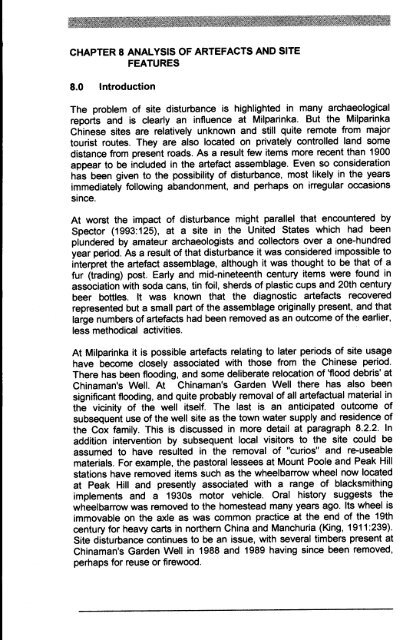Adec Preview Generated PDF File - The Sydney eScholarship ...
Adec Preview Generated PDF File - The Sydney eScholarship ...
Adec Preview Generated PDF File - The Sydney eScholarship ...
You also want an ePaper? Increase the reach of your titles
YUMPU automatically turns print PDFs into web optimized ePapers that Google loves.
CHAPTER 8 ANALVSIS OF ARTEFACTS AND SITE<br />
FEATURES<br />
8.0 Introduction<br />
<strong>The</strong> problem of site disturbance is highlighted in many archaeological<br />
reports and is clearly an influence at Milparinka. But the Milparinka<br />
Chinese sites are relatively unknown and still quite remote from major<br />
tourist routes. <strong>The</strong>y are also located on privately controlled land some<br />
distance from present roads. As a result few items more recent than 1900<br />
appear to be included in the artefact assemblage. Even so consideration<br />
has been given to the possibility of disturbance, most likely in the years<br />
immediately following abandonment, and perhaps on irregular occasions<br />
since.<br />
At worst the impact of disturbance might parallel that encountered by<br />
Spector (1993:125), at a site in the United States which had been<br />
plundered by amateur archaeologists and collectors over a one-hundred<br />
year period. As a result of that disturbance it was considered impossible to<br />
interpret the artefact assemblage, although it was thought to be that of a<br />
fur (trading) post. Early and mid-nineteenth century items were found in<br />
association with soda cans, tin foil, sherds of plastic cups and 20th century<br />
beer bottles. It was known that the diagnostic artefacts recovered<br />
represented but a small part of the assemblage originally present, and that<br />
large numbers of artefacts had been removed as an outcome of the earlier,<br />
less methodical activities.<br />
At Milparinka it is possible artefacts relating to later periods of site usage<br />
have become closely associated with those from the Chinese period.<br />
<strong>The</strong>re has been flooding, and some deliberate relocation of 'flood debris' at<br />
Chinaman's Well. At Chinaman's Garden Well there has also been<br />
significant flooding, and quite probably removal of all artefactual material in<br />
the vicinity of the well itself. <strong>The</strong> last is an anticipated outcome of<br />
subsequent use of the well site as the town water supply and residence of<br />
the Cox family. This is discussed in more detail at paragraph 8.2.2. In<br />
addition intervention by subsequent local visitors to the site could be<br />
assumed to have resulted in the removal of "curios" and re-useable<br />
materials. For example, the pastoral lessees at Mount Poole and Peak Hill<br />
stations have removed items such as the wheelbarrow wheel now located<br />
at Peak Hill and presently associated with a range of blacksmithing<br />
implements and a 1930s motor vehicle. Oral history suggests the<br />
wheelbarrow was removed to the homestead many years ago. Its wheel is<br />
immovable on the axle as was common practice at the end of the 19th<br />
century for heavy carts in northern China and Manchuria (King, 1911 :239).<br />
Site disturbance continues to be an issue, with several timbers present at<br />
Chinaman's Garden Well in 1988 and 1989 having since been removed,<br />
perhaps for reuse or firewood.




